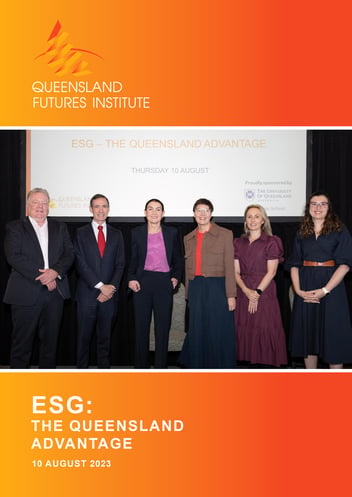|
This event was held on 10th August 2023. Business, finance and government leaders joined the panel to discuss Queensland’s progress and opportunity to achieve global advantage in ESG.
The key theme from the 2023 forum was the prominence of environmental, social and governance considerations at all levels of decision-making and reporting by businesses in Australia today. While European financial and sustainability standards have lead regulation globally, Queensland businesses and industry are well positioned to take advantage of the alignment and standardisation of these in coming years. The discussion also outlined the recent focus on social initiatives as a key driver of positive ESG outcomes and broader performance for businesses, as well as communities and the Queensland economy.

|
 |
|
Panelists
|
|
|
 |
 |
 |
Alicia Clarke
ESG Advisory and Assurance
Partner, PwC
|
Fiona Mann
Head of Listed Equities and ESG, Brighter Super |
Rebecca Pickering
Acting Chief Executive,
Inland Rail |
 |
 |
|
Brooke Veliscek
Director Infrastructure and Sustainability, The University of Queensland |
Moderator - Professor Shaun Bond
Deputy Head of School &
Frank Finn Chair in Finance
UQ Business School
|
Thank you to our event sponsor

|
Audience Comments on Ideas Discussed
| |
- A renewed emphasis on social initiatives of government, organisations and in projects across the state will contribute significantly to the state development currently underway. As discussed by the Panel, these may result in opportunities to grow local manufacturing, workforce training and development, and create opportunities for community engagement across Queensland. This would contribute to the state’s regional economic development.
- The alignment and standardisation of sustainability and financial reporting will be a significant development for Australian organisations. This will require significant work in order to start understanding what will be required of organisations, particularly small businesses. This will likely involve sharing learnings of ESG
initiatives across Queensland industries, and further exploring how these will be reported.
- We have an opportunity to leverage our existing strengths in the resource industry, for example, in producing critical minerals whilst achieving positive ESG outcomes. Taking advantage of these opportunities and continuing to deliver innovative approaches to ESG will attract investment to Queensland.
|
Comments from Panel

|
Professor Shaun Bond
- Since the early 2000s, sustainability and ESG have risen in prominence and
are now recognised within the corporate mindset as a critical component of
organisations. ESG now forms part of every decision and continues to be discussed in forums such as today’s panel.
|

|
Alicia Clarke
- The rapid changes around ESG that we’ve experienced over recent decades is
continuing at pace, and we are now seeing a wide range of standards converge.
- The International Sustainability Standards Board (ISSB) was started in 2021.
Its creation reflects the recognition that standards and the regulatory environment around ESG was complex, and confused investors and regulators alike. For example, the ESG landscape had numerous standards and practices. This is unlike securities regulation in Australia for example, where the ASX sets reporting standards and principles for investors. This regulatory complexity was likely caused by the contentiousness of ESG and the varying degrees of its application across past decades.
- In a recent annual PwC survey of the ASX200, the number of companies that
disclosed a net zero commitment increased last year by about 13% - to 49%.
But only just over half of these companies had disclosed a transition plan.
• We are now seeing a push towards new regulation around transparency in this
reporting and disclosure of how organisations will achieve it. However, we know
that vast technological change is needed to achieve 2050 decarbonisation goals,
so these regulations and the efforts around ESG need to reflect this uncertainty.
|

|
Fiona Mann
- Brighter Super always considers the greater purpose of ESG within its investments. We consider ESG through framing it as a risk – not only a corporate risk, but as an investment risk. This is present across almost all of our investment portfolio, and allows for the consideration of ESG alongside other corporate, investment, reputation and regulatory/transition risk. At an asset level it is important to remember that broader physical also exists. This risk perspective allows us to consider ESG and the overall preservation of capital and act in members’ best financial interests.
- This leads to the four pillars we use in considering ESG within our fund. The first
is to act in members’ best financial interest. The next is considering its impact on
risk and return profile, which must be negligible. These activities must also be
genuine in intent and outcome – for example we don’t just undertake ESG activities to attract headlines, we do it because we genuinely believe it will benefit our members. Finally, we consider the role of our fund in the broader decarbonisation story. We look to transition where possible and not divestment. While we could decarbonise our portfolio tomorrow, this wouldn’t necessarily contribute to broader decarbonisation. Together, this shows how considering the broader impacts of ESG related risk within our fund contributes to doing the best for our members.
|

|
Rebecca Pickering
- Inland Rail is an important project to meet Australia’s growing freight task, improve road safety and help decarbonise our economy. This project allows us to look at a far more efficient way of moving freight around the country by connecting Australia’s two fastest-growing capital cities - Melbourne and Brisbane. Each train using Inland Rail will be able to carry the equivalent volume of 110 B-double trucks.
- Given this size and opportunity, it is often said that it should have been built 50
years ago, as it would be an incredible piece of infrastructure. It would also support regional areas across Queensland, New South Wales and Victoria.
- The opportunities around this project will be delivered through its scale. It will bring forward new technology, and ways of embedding sustainability within the delivery of capital infrastructure. In this sense, the project delivery goes hand-in-hand with sustainability, and covers how we engage contractors, select materials, build a workforce and engage local businesses.
- The Infrastructure Sustainability Council is the rating agency that accredits major
projects and develops standards for projects like ours, which is required for some
approvals processes. There is a strong need to ensure standards like these keep
pace with the technology and capability of leading infrastructure projects like Inland Rail. If this is achieved, these projects will catalyse advancements in sustainability across their supply chains and change how we deliver all projects, no matter their size. Inland Rail has a dedicated sustainability team who are trying to push the boundaries and take advantage of the opportunities to achieve this.
|

|
Brooke Veliscek
- The Centre for Natural Gas at the University of Queensland is a very broad coalition dealing with matters around the energy transition. We are currently experiencing a tale of two transitions. Firstly, there is the type of transition we are seeing play out in Queensland and across the OECD countries. Then secondly, there is the real transition in the many other areas of the world – including India, China and Africa – which represents the significant area for decarbonisation. Queensland currently consumes about 25% – 1,450PJ of Australia’s energy, 92% of which is fossil fuels – 36% from oil, 35% from coal, 21% from gas – and only 8% from renewables.
- However, the transition is currently largely focused on electricity. If our goal is decarbonisation more broadly, we must think broader than just electricity – and not focus on the number of solar panels or batteries we have.
- There are a number of other considerations that must be made when thinking about energy more broadly. For example, when Ukraine was invaded by Russia we saw an immediate fear for energy supplies – manifesting through increased petrol prices when only 2-5% of global oil supply was under threat. This impacted the lower socioeconomic demographics hardest. On a global scale, rich countries soon outbid the poor countries for gas, and over that period of restricted gas supply we saw an increase in emissions as poorer countries reverted to coal for power generation. Over a hundred million people fell into energy poverty. This meant that 75 million people went from using LPG for cooking to wood, charcoal, and dung. Additionally, 300 million people went into food poverty, as urea and fertiliser shortages occurred and energy inputs to agriculture also increased (and less fertiliser use in 2022 can be expected to have knock on effects on productivity in 2023 onwards).
- The lesson from the above impacts of the Ukraine crisis highlights the need to ensure affordability, reliability and security alongside decarbonisation. Risk management around supply is critical as without this, we may see an increase in energy poverty in Queensland due to another price spike and a loss of ‘social licence to decarbonise’.
|
Panel Questions
Organisations face a bewildering variety of ESG measures and scores when considering how to
signal their commitment to these important issues. What measures or benchmarks do you focus
on in your organisation and why?

|
Rebecca Pickering
- Inland Rail follows the Infrastructure Sustainability Council rating system, which is
comprised of around 15 categories that cover various aspects of projects such as
waste management, project procurement, impacts of land and water, and community engagement. We are compliant across measurements, which provide a reputable standard against which to measure our impact.
- Inland Rail is part of a broader corporation, Australian Rail Track Corporation,
which brings increased complexity around the standards and schemes which
apply. We provide annual disclosure aligned with the Task Force on Climate-Related Financial Disclosure and have signed up to the United Nations Global Compact, under which we measure our impacts around procurement and labour. These are examples of many of the various standards and approaches to measurement around sustainability.
- Given the many approaches described above, we have found that engagement
with financiers has provided clarity around which expectations and standards apply. This partnership between infrastructure delivery and the finance sector has been extremely helpful in navigating this space.
- Internally, Inland Rail is focused on engagement with the community. This includes considering the impacts for landowners to ensure people understand our project. This draws out the social element of ESG.
- There has been increasing scrutiny around the governance aspects of ESG, and we
have sought input and support from our shareholders, the government, and industry more broadly to determine best practice. Again, there are many approaches to this, and different businesses or projects will have their own metrics which are most meaningful to them and their key stakeholders.
|

|
Fiona Mann
- The Brighter Super portfolio spans various asset classes. Because of this, our
infrastructure, property and equity managers each use the standards most pertinent to their own areas; infrastructure managers use similar metrics to those of Inland Rail, property managers may use NABERS or five-star ratings, and equity managers use the regulations of their geography. We have seen that Europe is ahead of other markets on regulation and sustainability, but this has seen countless standards and schemes emerge, including the Corporate Sustainability Due Diligence Directive (CSDDD), Corporate Sustainability Reporting Directive (CSRD), Green Claim Directive (GCD), European Sustainability Reporting Standards (ESRS), and the regulation with the worst ever acronym , the Prohibiting Products Made with Forced Labour on the Union Market Regulation (PPMFLR).
- But this long list of regulations must be supported by reliable ESG data. This has
been worked on since 2015, in work undertaken by the International Sustainability
Standards Board - one of two boards under the International Financial Reporting
Standards Board (the other being the International Accounting Standards Board).
- Following a recent release of regulations from the Board, the Australian Treasury
released a consultation paper exploring how sustainability standards can be
implemented in Australia. It is currently proposed that this will be tied to the Australian Accounting Standards Board, which would result in climate and the sustainability reporting sitting alongside financial reporting. This would integrate sustainability and finance teams across organisations and give a complete perspective across reporting. These frameworks provide the impetus to developing sustainability reporting in Australia, which may begin to emerge over the coming 12 months.
|
The Queensland Government has set out very ambitious plans to transform the economy to a more
sustainable footing with the Queensland Energy and Jobs plan. A substantive part of the plan is to
move to 70% renewable energy by 2032. How important are these state level initiatives in the ESG
considerations of your organisations?

|
Brooke Veliscek
- UQ and many other educational institutes are conducting great research around
these developments. In 2014 The University of Queensland 3.3MW Gatton Solar
Farm was one of the largest in the state and the largest research facility when it
was built. This is now small compared to the energy developments the state is
seeing today. However, the learnings from this initial project were applied across
other university investments, some of which include UQ’s rooftop solar, battery
deployment and other decarbonisation activities. UQ also built a larger facility in
Warwick Solar Farm, which is now operating at a full capacity of 64MW connected
to the National Electricity Market. The jump from 3.3MW to 64MW is significant,
however this is still relatively small compared to other large-scale developments that are now constructed in Queensland. This journey and the learnings exemplify the immensely transitional period renewables are undergoing in the state today.
- We must continue to apply these learnings in the years to come in order to achieve the state’s targets. Importantly, we must also understand that progress isn’t linear – it may jump or stagnate, and that is okay. It is during these periods of stagnations when we can apply the learnings, innovate, and build momentum to progress. With this collaborative and innovative progress, we can also align the targets of the state with those of our organisations.
|
Does the current carbon-intensive nature of the state hinder/harm the ESG credentials of Queensland businesses?

|
Alicia Clarke
- There are both risks and opportunities associated with Queensland’s carbon-intensive industries. In addition to the standards already discussed, the Safeguard Mechanism is Australia’s regulation on the largest polluters. Queensland is the second highest state behind WA by number of these facilities which form some of the largest Scope One emitters. However, with the Queensland Energy and Jobs Plan and our resource industry, there is a significant opportunity to become a greener state.
- Some of these opportunities stem from our critical mineral resources and regional developments such as the Renewable Energy Zones, Clean Energy Hubs, and the potential for local manufacturing, which will all bring economic opportunity across the state. With this, there will also be opportunity from an ESG perspective, as organisations focus on the elements of this transition most material to them.
- However, there are also some risks around this – namely the global supply chain
issues. Ensuring an attractive investment environment for Queensland and
Australia relative to Europe and the US will be critical to take advantage of these
developments and overcome the associated risks. Other considerations around
workforce and infrastructure delivery will also be key to mitigating these risks.
|
The discussion on ESG and sustainability has progressed significantly over the last 20 years and
is now a core part of almost all business considerations. However, while firms are very focused on
the environmental and governance aspects, there is less recognition of the social aspect. How are
your organisations developing and implementing strategies to address this?

|
Fiona Mann
- The focus on climate sustainability is certainly clear through both industry
engagement and in ISSB reporting, while governance has actually been explored for the longest time of the three aspects of ESG.
- A key element for the social aspect is around modern slavery reporting. This was
probably the first to be legislated in Australia. More recently, organisational culture is emerging as a key focus.
- From a fund management perspective, culture is now considered a key contributor to excess return - or alpha – for investments, and something that can drive longterm value. This involves considering organisations’ cultures and treatment of workforces – for example, examining diversity and inclusion.
- Organisations must start to consider how they will implement frameworks to
achieve positive culture. We’re now seeing this result in more engagement around
Reconciliation Action Plans, and – to use the energy transition as an example –
community engagement. In Brighter Super, examples of this include our property
managers being involved in the communities of our assets, and infrastructure assets having sustainability-linked loans which require diversity and inclusion targets. These all contribute to increased returns and value in the long-term.
|

|
Rebecca Pickering
- Inland Rail is very focused on the impact of our project. Given the nature of the project, it is clear where communities will be impacted and where we can create employment and training opportunities and engage the communities around these impacts.
- Given a high level of local procurement, this mitigates exposure to supply chain
issues around modern slavery and creates a lot of transparency in where we are
procuring from. This is a focus for many businesses, who are increasingly focusing
on how their supply chains operate and can be verified.
- As a large infrastructure project, Inland Rail will help to set a precedent on how
to best deal with these risks and create opportunities across engagement and
procurement for other businesses.
- As an example of a social initiative, we launched the Inland Rail Skills Academy
over four years ago, which creates local benefits while reducing the risk of workforce constraints. We foresaw a huge workforce demand, potentially a net increase of 20,000 direct and indirect jobs during construction in Australia as a result of our project, so building local skills and capability has been a critical part of the project.
|
|
Audience Questions
To apply the mitigation and adaptation framing of disaster resilience to ESG, we know adaptation
measures are a significant capital burden. How do you deal with such budget pressure in dealing
with these risks and adversities within ESG?
|

|
Fiona Mann
- A large number of real assets in the Brighter Super’s portfolio consider the physical
risks of climate change. For example, we map the impacts of temperature changes
on shopping centres, thinking about the operation costs of air conditioning. Another example is considering the impacts of rising waters on port assets. These risks are often reflected in insurance costs of at-risk assets, so it is critical to understand these risks in the management of these real assets.
|

|
Brooke Veliscek
- There is a significant component of the new sustainability standards around climate change resilience for assets. However, this risk analysis is not new; Infrastructure Australia and some major projects have considered these risks and undertaken climate and resilience forecasting for many years. This will clearly continue to be an important consideration into the future.
|

|
Professor Shaun Bond
- Through my research around physical mitigation and resiliency during disasters in
the US, there is also a strong emphasis on economic resiliency. This forms a strong
predictor of how fast areas return to normality after a crisis.
|
Given the many standards and regulatory developments we will see in the near future, what can
organisations do today to prepare for the reporting and compliance standards they will need to
meet in coming years?

|
Alicia Clarke
- The recent consultation paper mentioned earlier proposed standards could
be implemented for the largest organisations first (by 2024-25) and smallest
organisations last (by 2027-28). For smaller organisations, there is a lot of work
to do to start to understand their carbon footprint etc., which large organisations
generally already have a better understanding of. Understanding Scope Three
emissions may be the most challenging requirement for small organisations, which is why this timeline provides the additional few years.
- Collaboration across industry will be critical in order to understand and meet these requirements. The Climate Leaders Coalition is a great example of this – which outlines approaches to Scope Three calculation and is written by CEOs, for CEOs. We will also likely see collaboration in information sharing across supply chains.
- We will continue to see more transparency as these frameworks come into force
and are aligned with Australian accounting standards.
|

|
Fiona Mann
- Another positive development is that the quality of data has significantly improved in recent years, which should assist in meeting these standards. As these standards are implemented, this will improve the quality and transparency provided by this data again.
|
| |
|
























